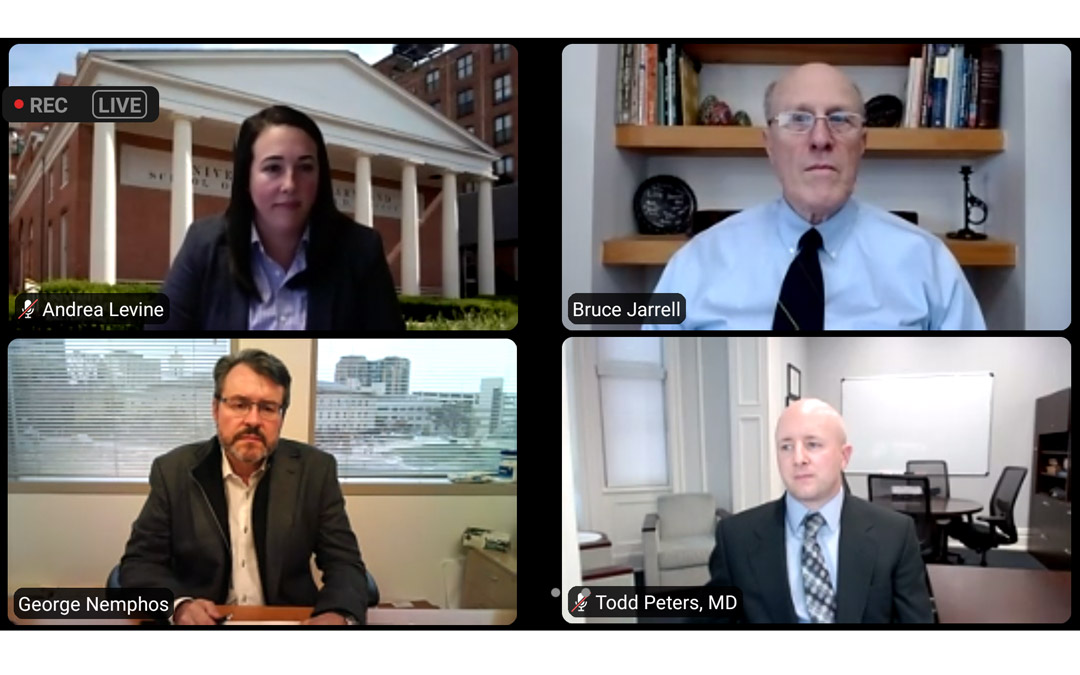November 2020
University of Maryland, Baltimore (UMB) President Bruce E. Jarrell, MD, FACS, participated in Jmore magazine’s second annual JBiz Innovation in Health Care panel discussion Oct. 27, providing his insights on COVID-19 vaccine clinical trials, how Maryland citizens can stay healthy this winter, and UMB’s response to the pandemic.

Clockwise from top left: Andrea Levine, Bruce Jarrell, Todd Peters, and George Nemphos. (Photo courtesy of Jmore)
“We’re in this situation with COVID-19 for a few more months, and probably longer than that the way things are looking right now,” said Jarrell, who fielded questions from the virtual event’s moderator, George Nemphos, JD, LLM, of Nemphos Braue Attorneys at Law. “But we’ve been doing well. I think the University is healthy and people have been extremely cooperative during these very difficult times.”
Jmore publisher Scott Rifkin, MD, led off the event by introducing Jarrell, Nemphos, and the two other panelists: Andrea Levine, MD, MS, assistant professor of medicine and program director, Critical Care Medicine Fellowship, at the University of Maryland School of Medicine (UMSOM), and Todd Peters, MD, vice president and chief medical officer of Sheppard Pratt Health Systems.
Jarrell first discussed how the University responded to the pandemic in mid-March, when UMB leadership decided to implement telework for a majority of employees and curtail in-person clinical education for students. He noted that schools now are moving back to in-person clinical rotations, didactic education remains mostly remote, and basic research is at 50 percent capacity to keep the on-campus population density low.
Asked about the efforts to fight COVID-19 at UMB, Jarrell singled out the lab of Matthew Frieman, PhD, a microbiologist at UMSOM who has been studying coronaviruses for over a decade, and praised UMSOM’s Center for Vaccine Development and Global Health (CVD), which is conducting COVID-19 vaccine clinical trials.
“The Center for Vaccine Development has a spectacular reputation for being able to stand up vaccine clinical trials almost overnight, yet to do it in a highly efficient manner,” said Jarrell, who is participating in a CVD trial of a vaccine co-developed by Moderna, Inc., and the National Institute of Allergy and Infectious Diseases. “CVD has a really robust capability, and Maryland should be proud to have a program like that in our state.”
Jarrell implored people of all backgrounds to participate in these trials and mentioned CVD’s efforts to recruit Latino and African American volunteers in Maryland, particularly in Prince George’s County and Baltimore.
“I urge everybody listening to keep your ear out for this kind of opportunity because we need volunteers,” Jarrell said. “I’m participating in CVD’s trial with Moderna. It’s the fifth vaccine trial I’ve volunteered for. It hasn’t hurt me, and it’s probably helped me.”
Asked about the state of Maryland’s fight against COVID-19, Jarrell said he’s worried about infection rates and the coming winter months. He praised Gov. Larry Hogan’s leadership during the crisis, pointing out the makeup of his Coronavirus Response Team, which includes UMSOM faculty members Wilbur Chen, MD, MS, and David Marcozzi, MD.
“The governor has made some excellent decisions,” Jarrell said. “One of the best things he did was to get a group of physicians and experts in epidemiology, vaccinology, and emergency medicine around him and then follow their advice.”
Moving forward, Jarrell said Marylanders need to remain vigilant in protecting themselves from the virus by adhering to the now well-known health safety protocols regarding COVID-19.
“There is extremely good data to show that if you follow the precautions religiously, you will protect yourself,” he said. “Washing your hands, wearing a mask, physical distancing — these methodologies work to limit the spread of this disease.”
Levine, meanwhile, discussed her experiences working with COVID-19 patients at the University of Maryland Medical Center (UMMC), where she is a critical care specialist.
“I spent four to six weeks caring for COVID-19 patients in our ICU and a countless number of weeks caring for patients in our outpatient clinic who are COVID-19 survivors,” she said. “I actually took care of the first patient in our hospital who had COVID-19, so I’ve been involved in this since the very beginning.”
Levine detailed how UMMC converted its intensive care units (ICU) into fully isolated biocontainment units to keep patients and staff as safe as possible, adding that she and her colleagues received insight from colleagues in New York who were dealing with an onslaught of COVID-19 patients in the spring.
“There was a vertical learning curve involved with the logistics of caring for patients in these units,” Levine said. “It was really incredible to watch parts of the hospital transform into totally different-looking units. I feel honored to have taken care of these patients and to have been on the front lines, but it has certainly been a difficult couple of months.”
Peters, an expert in child and adolescent psychology, talked about how Sheppard Pratt’s walk-in clinic was shifted to a virtual platform and said the expansion of its telehealth program during the pandemic has been a success.
“Our scale has grown exponentially, and it has allowed us to reach out to larger audiences than we ever have previously,” Peters said. “This has allowed us to provide direct care to individuals in their homes, meet them at a time of crisis, and actually refer them to more acute outpatient services or even inpatient services if needed.”
Read more about the event here.
Search UMB News
Sign up for UMB Alerts.



